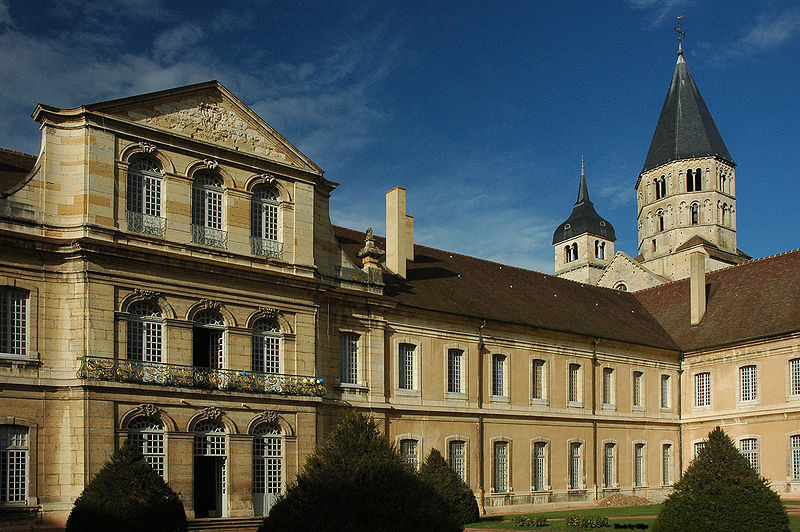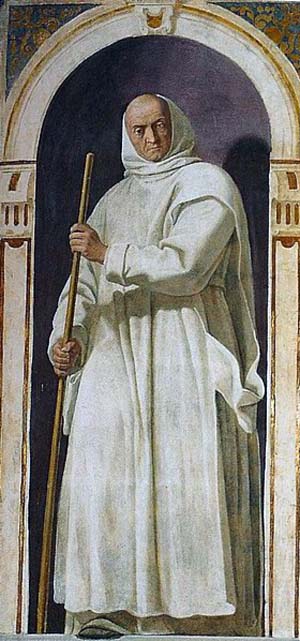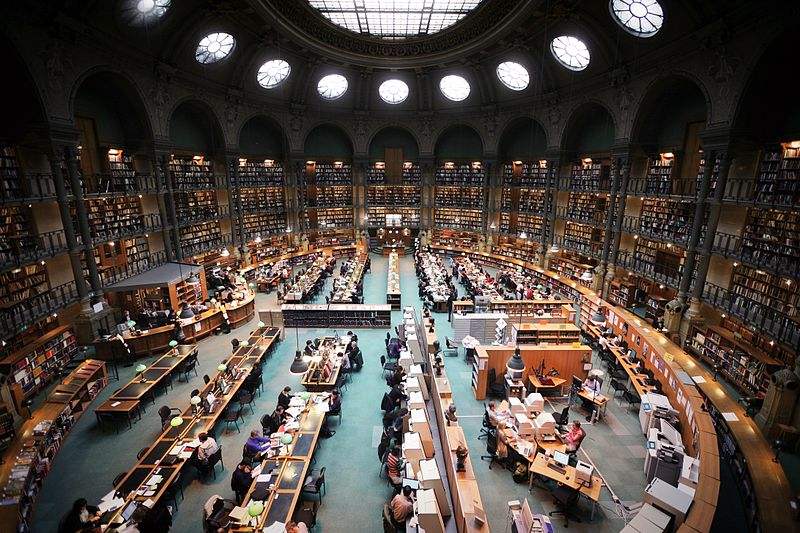COMO O FEUDALISMO REFORMOU E REVIVEU O MONAQUISMO - CLUNY
Texto: Inglês e Português
Fonte: Nobility Org.
How Feudalism reformed and revived monasticism: Cluny
(CLUNI, CLUGNI, or CLUGNY)
The earliest reform, which became practically a distinct order, within the Benedictine family. It originated at Cluny, a town in Saone-et-Loire, fifteen miles north-west of Macon, where in 910 William the Pious, Duke of Aquitaine, founded an abbey and endowed it with his entire domain. Over it he placed St. Berno, then Abbot of Gigny, under whose guidance a somewhat new and stricter form of Benedictine life was inaugurated. The reforms introduced at Cluny were in some measure traceable to the influence of St. Benedict of Aniane, who had put forward his new ideas at the first great meeting of the abbots of the order held at Aachen (Aix-la-Chapelle) in 817, and their development at Cluny resulted in many departures from precedent, chief among which was a highly centralized form of government entirely foreign to Benedictine tradition. The reform quickly spread beyond the limits of the Abbey of Cluny, partly by the founding of new houses and partly by the incorporation of those already existing, and as all these remained dependent upon the mother-house, the Congregation of Cluny came into being almost automatically. Under St. Berno’s successors it attained a very widespread influence, and by the twelfth century Cluny was at the head of an order consisting of some 314 monasteries. These were spread over France, Italy, the Empire, Lorraine, England, Scotland, and Poland. According to the “Bibliotheca Cluniacensis” (Paris, 1614) 825 houses owed allegiance to the Abbot of Cluny in the fifteenth century. Some writers have given the number as 2000, but there is little doubt that this is an exaggeration. It may perhaps include all those many other monasteries which, though no joining the congregation, adopted either wholly or in part the Cluny constitutions, such as Fleury, Hirschau, Farfa, and many others that were subject to their influence.
During the first 250 years of its existence Cluny was governed by a series of remarkable abbots, men who have left their mark upon the history of Western Europe and who were prominently concerned with all the great political questions of their day. Among these were Sts. Odo, Mayeul, Odilo, and Hugh, and Peter the Venerable. Under the last named, the ninth abbot, who ruled from 1122 to 1156, Cluny reached the zenith of its influence and prosperity, at which time it was second only to Rome as the chief centre of the Christian world. It became a home of learning and a training school for popes, four of whom, Gregory VII (Hildebrand), Urban II, Paschal II, and Urban V, were called from its cloisters to rule the Universal Church. In England the Cluniac houses numbered thirty-five at the time of the dissolution. There were three in Scotland. The earliest foundation was that of the priory of St. Pancras at Lewes (1077), the prior of which usually held the position of vicar-general of the Abbot of Cluny for England and Scotland. Other important English houses were at Castleacre, Montacute, Northampton, and Bermondsey.

After the twelfth century the power of Cluny declined somewhat, and in the sixteenth century it suffered much through the civil and religious wars of France and their consequences. The introduction also of commendatory abbots, the first of whom was appointed in 1528, was to some extent responsible for its decline. Amongst the greatest of its titular prelates were Cardinals Richelieu and Mazarin, who tried to restore it to some of its former greatness, though their efforts did not meet with much success. Claude de Vert, Prior of Saint-Pierre, Abbeville (d. 1708), was another would-be reformer of the congregation, inspired no doubt by the example of the Maurists.
The abbey-church of Cluny was on a scale commensurate with the greatness of the congregation, and was regarded as one of the wonders of the Middle Ages. It was no less than 555 feet in length, and was the largest church in Christendom until the erection of St. Peter’s at Rome. It consisted of five naves, a narthex, or ante-church, and several towers. Commenced by St. Hugh, the sixth abbot, in 1089, it was finished and consecrated by Pope Innocent II in 1131-32, the narthex being added in 1220. Together with the conventual buildings it covered an area of twenty-five acres. At the suppression in 1790 it was bought by the town and almost entirely destroyed. At the present day only one tower and part of a transept remain, whilst a road traverses the site of the nave. The community of the abbey, which had numbered three hundred in the thirteenth century, dwindled down to one hundred in the seventeenth, and when it was suppressed, in common with all the other religious houses in France, its monks numbered only forty.
The spirit and organization of the congregation was a distinct departure from the Benedictine tradition, though its monks continued all along to be recognized as members of the Benedictine family. Previous to its inception every monastery had been independent and autonomous, though the observance of the same rule in all constituted a bond of union; but when Cluny began to throw out offshoots and to draw other houses under its influence, each such house, instead of forming a separate family, was retained in absolute dependence upon the central abbey. The superiors of such houses, which were usually priories, were subject to the Abbot of Cluny and were his nominees, not the elect of their own communities, as is the normal Benedictine custom. Every profession, even in the most distant monastery of the congregation, required his sanction, and every monk had to pass some years at Cluny itself. Such a system cut at the root of the old family ideal and resulted in a kind of feudal hierarchy consisting of one great central monastery and a number of dependencies spread over many lands. The Abbot of Cluny or his representative made annual visitations of the dependent houses, and he had for his assistant in the government of so vast an organization a coadjutor with the title Grand-Prior of Cluny. The abbot’s monarchical status was somewhat curtailed after the twelfth century by the holding of general chapters, but it is evident that he possessed a very real power over the whole congregation, so long as he held in his own hands the appointment of all the dependent priors. (For the sources of information as to the rule, government, and conventual observance of the congregation, see bibliography at end of this article.) With regard to the Divine Office, the monks of Cluny conformed to the then prevailing custom, introduced into the monasteries of France by St. Benedict of Aniane, of adding numerous extra devotional exercises, in the shape of psalms (psalmi familiares, speciales, prostrati, and pro tribulatione) and votive offices (Our Lady, The Dead, All Saints, etc.) to the daily canonical hours prescribed by the Benedictine Rule.
The library of Cluny was for many centuries one of the richest and most important in France and the storehouse of a vast number of most valuable manuscripts. When the abbey was sacked by the Huguenots, in 1562, many of these priceless treasures perished and others were dispersed. Of those that were left at Cluny, some were burned by the revolutionary mob at the time of the suppression in 1790, and others stored away in the Cluny town hall. These latter, as well as others that passed into private hands, have been gradually recovered by the French Government and are now in the Bibliotheque Nationale at Paris. There are also in the British Museum, London, about sixty charters which formerly belonged to Cluny. The “Hotel de Cluny” in Paris, dating from 1334, was formerly the town house of the abbots. In 1833 it was made into a public museum, but apart from the name thus derived, it possesses practically nothing connected with the abbey.
For the rule, constitutions, etc., see BERNARD OF CLUNY, Ordo Cluniacensis in HERRGOTT, Vetus Disciplina Monastica (Paris, 1794); and UDALRIC OF CLUNY, Consuetudines Cluniacensis in P.L., CXLIX (Paris, 1882). For the history of the congregation, etc., DUCKET, Charters and Records of Cluni (Lewes, 1890); MAITLAND, Dark Ages (London, 1845); MABILLON, Annales O. S. B. (Paris, 1703-39), III-V; SAINTE-MARTHE, Gallia Christiana (Paris, 1728), IV, 1117; HELYOT, Hist. des ordres religieux (Paris, 1792), V; MIGNE, Dict. des abbayes (Paris, 1856); LAVISSE, Hist. de France (Paris, 1901), II, 2; LORAIN, Hist. de l’abbaye de Cluny (Paris, 1845); CHAMPLY, Hist. de Cluny (Macon, 1866); HEIMBUCHER, Die Orden und Kongregationen der katholischen Kirche (Paderborn, 1896), I; HERZOG AND HAUCK, Realencyklopadie (Leipzig, 1898), III; SACKUR, Die Cluniacenser (Halle a. S., 1892-94).
G. CYPRIAN ALSTON (Catholic Encyclopedia)
TRADUÇÃO - PORTUGUÊS
Como Feudalismo reformou e reviveu o monaquismo : Cluny
Congregação de Cluny( CLUNI , CLUGNI , ou Clugny )
Abadia de Cluny hojeA primeira reforma , que se tornou praticamente uma ordem distinta , na família beneditina. Originou-se em Cluny , uma cidade em Saone-et- Loire , 15 milhas a noroeste de Macon, onde em 910 William , o Piedoso , duque de Aquitânia, fundou um mosteiro e dotou -a com todo o seu domínio. Sobre ele colocou St. Berno , então Abade de Gigny , sob cuja orientação um pouco novo e mais rigorosa forma de vida beneditina foi inaugurada . As reformas introduzidas em Cluny estavam em alguma medida rastreável à influência de São Bento de Aniane , que apresentou suas novas idéias na primeira grande reunião dos abades da ordem realizado em Aachen ( Aix -la- Chapelle ) em 817 e seu desenvolvimento em Cluny resultou em muitas partidas do precedente , o principal dos quais era uma forma altamente centralizada de governo inteiramente estranha a tradição beneditina . A reforma rapidamente se espalhou para além dos limites da Abadia de Cluny, em parte pela fundação de novas casas e em parte pela incorporação das já existentes , e como todos estes permaneceram dependentes da casa-mãe , a Congregação de Cluny surgiu quase automaticamente . Sob os sucessores de St. Berno , atingiu uma influência muito difundida, e por volta do século XII Cluny estava na cabeça de uma ordem composto por cerca de 314 mosteiros. Estes foram distribuídos por França, Itália , o Império , Lorena, Inglaterra , Escócia e Polónia . De acordo com a " Bibliotheca Cluniacensis " (Paris , 1614 ) 825 casas deviam obediência ao abade de Cluny , no século XV . Alguns escritores têm dado o número de 2000, mas há pouca dúvida de que este é um exagero. Talvez possa incluir todos aqueles muitos outros mosteiros que, apesar de não se juntar à congregação , adotadas no todo ou em parte, as constituições Cluny , como Fleury, Hirschau , Farfa , e muitos outros que estavam sujeitos à sua influência.
Durante os primeiros 250 anos de sua existência Cluny foi governado por uma série de abades notáveis , homens que deixaram sua marca na história da Europa Ocidental e que foram destaque em causa com todas as grandes questões políticas de sua época . Entre estes estavam os Santos . Odo , Mayeul , Odilo , e Hugh , e Pedro, o Venerável . De acordo com o último nomeado, o nono abade , que governou 1122-1156 , Cluny atingiu o auge de sua influência e de prosperidade , momento em que ele foi perdendo apenas para Roma como o centro principal do mundo cristão . Tornou-se uma casa de aprendizagem e de uma escola de treinamento para os papas , quatro dos quais , Gregório VII ( Hildebrando ) , Urbano II , Pascoal II e Urbano V, eram chamados de seus claustros para governar a Igreja Universal. Na Inglaterra, as casas de Cluny contados trinta e cinco anos , no momento da dissolução . Havia três na Escócia. O primeiro fundamento era a do convento de St. Pancras em Lewes ( 1077 ), a prévia do que normalmente ocupava o cargo de vigário - geral do Abade de Cluny para a Inglaterra e Escócia. Outras casas inglesas importantes estavam em Castleacre , Montalvânia , Northampton, e Bermondsey .
Após o século XII, o poder de Cluny diminuído um pouco , e no século XVI, que sofreu muito com as guerras civis e religiosas da França e suas conseqüências. A introdução também de abades de recomendação , o primeiro dos quais foi nomeado, em 1528, foi de certa forma responsável por seu declínio. Entre o maior de seus prelados titulares eram cardeais Richelieu e Mazarin , que tentou restaurá-lo para um pouco de sua antiga grandeza , apesar de seus esforços não se encontrou com muito sucesso. Claude de Vert , Prior de Saint- Pierre, Abbeville (d. 1708), foi outro pretenso reformador da congregação, inspirado , sem dúvida, pelo exemplo dos Maurists .
A abadia de Cluny - igreja estava em uma escala compatível com a grandeza da congregação, e foi considerado como uma das maravilhas da Idade Média . Era nada menos que 555 pés de comprimento, e foi a maior igreja da cristandade até a construção de São Pedro em Roma. Ela consistia de cinco naves, um nártex , ou ante - igreja , e várias torres. Iniciada por St. Hugh , o sexto abade, em 1089 , foi terminado e consagrado pelo Papa Inocêncio II , em 1131-1132 , o nártex que está sendo adicionado em 1220 . Juntamente com os edifícios conventuais que cobria uma área de vinte e cinco hectares . Na supressão em 1790 foi comprada pela cidade e quase totalmente destruída. Hoje em dia apenas uma torre e parte de um transepto permanecem, enquanto a estrada atravessa o local da nave. A comunidade da abadia , que tinha numeradas trezentos , no século XIII , diminuiu para cem no século XVII , e quando foi suprimida, em comum com todas as outras casas religiosas na França , seus monges eram apenas quarenta.
O espírito ea organização da congregação foi uma partida diferente da tradição beneditina , apesar de seus monges continuaram durante todo o tempo a ser reconhecidos como membros da família beneditina. Anterior a sua criação, cada monastério tinha sido independente e autônoma , embora a observância da mesma regra em todos constituiu um laço de união ; mas quando Cluny começou a expulsar ramificações e tirar outras casas sob sua influência , cada tal casa, em vez de formar uma família separada, foi mantido em absoluta dependência da abadia central. Os superiores de tais casas , que eram geralmente priorados , estavam sujeitos ao abade de Cluny e eram os seus candidatos , e não os eleitos de suas próprias comunidades , como é o costume beneditino normal. Toda profissão , mesmo no mosteiro mais distante da congregação, exigiam a sua sanção , e cada monge teve que passar alguns anos na própria Cluny. Tal sistema cortar na raiz do velho ideal da família e resultou em uma espécie de hierarquia feudal que consiste em um grande mosteiro central e um número de dependências espalhadas por muitas terras. O abade de Cluny ou do seu representante fez visitações anuais das casas dependentes, e que ele tinha para seu assistente no governo de tão vasto uma organização um coadjutor com o título de Grande - Antes de Cluny. Estado monárquico do abade foi um pouco reduzido a partir do século XII, com a realização de capítulos gerais , mas é evidente que ele possuía um poder muito real sobre toda a congregação , enquanto ele segurava em suas próprias mãos a nomeação de todos os priores dependentes . (Para as fontes de informação quanto à regra , o governo ea observância conventual da congregação, ver bibliografia no final deste artigo.) Com relação ao Ofício Divino , os monges de Cluny conformeis com o costume então vigente, introduzida no mosteiros da França por São Bento de Aniane , da adição de inúmeros exercícios extras devocionais , na forma de salmos ( Psalmi Familiares , speciales , Prostrati e pró tribulatione ) e escritórios votivas ( Nossa Senhora , The Dead , Todos os Santos, etc ) para as horas canônicas diárias prescritas pela Regra beneditina .Bibliothèque Nationale de France . Foto por Vincent Desjardins .
A biblioteca de Cluny foi durante muitos séculos uma das mais ricas e mais importante em França e no armazém de um grande número de manuscritos mais valiosos. Quando a abadia foi saqueada pelos huguenotes , em 1562 , muitos destes tesouros inestimáveis morreram e outros foram dispersos . Daqueles que foram deixados em Cluny, alguns foram queimados pela multidão revolucionária na época da supressão , em 1790 , e outros guardado na prefeitura Cluny. Estes últimos , assim como os outros que passaram para mãos privadas , têm sido gradualmente recuperado pelo Governo francês e agora estão na Biblioteca Nacional de Paris. Há também no Museu Britânico , em Londres, cerca de sessenta cartas que pertenciam anteriormente ao Cluny. O " Hotel de Cluny ", em Paris , que data de 1334, antigamente era a casa da cidade dos abades . Em 1833, foi transformado em um museu público , mas além do nome , portanto, derivada, ele possui praticamente nada relacionado com a abadia.
Para a regra , as constituições , etc , ver Bernardo de Cluny, Ordo Cluniacensis em Herrgott , Vetus Disciplina Monástica (Paris, 1794) ; e UDALRIC de Cluny , Consuetudines Cluniacensis no PL, CXLIX (Paris, 1882) . Para a história da congregação, etc , Ducket , Charters e Registros de Cluni ( Lewes, 1890) ; Maitland, Dark Ages ( Londres, 1845 ); Mabillon , Annales OSB (Paris, 1703-1739 ) , III- V; SAINTE -Marthe , Gallia Christiana (Paris, 1728 ) , IV, 1117 ; HELYOT , Hist . des ordres religieux (Paris, 1792) , V; MIGNE , Dict. des abbayes ( Paris , 1856 ) ; Lavisse , Hist . de France ( Paris , 1901) , II, 2; Lorain, Hist. de l' Abbaye de Cluny (Paris, 1845) ; CHAMPLY , Hist . de Cluny ( Macon, 1866) ; Heimbucher , Die Orden und der Kongregationen Katholischen Kirche (Paderborn , 1896) , I; Herzog e HAUCK , Realencyklopadie (Leipzig , 1898) , III; Sackur , Die Cluniacenser ( Halle a. S., 1892-1894 ) .G. Cipriano ALSTON ( Enciclopédia Católica )






Sem comentários:
Enviar um comentário